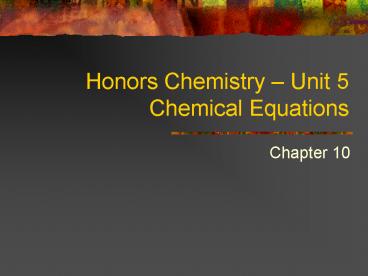Honors Chemistry - PowerPoint PPT Presentation
1 / 29
Title: Honors Chemistry
1
Honors Chemistry Unit 5Chemical Equations
- Chapter 10
2
What is a chemical rxn?
- A process where one or more substances changes to
one or more other substances. - Exchange of electrons!!!
- This is NOT a nuclear rxn! All atoms remain the
same they just rearrange
3
Parts of a chemical reaction
- Reactants the original substances
- Products the resulting substances
4
ASK YOURSELF
- Which are the products and which are the
reactants in these equations? - Na Cl- ?NaCl
- 2H2O ? 2H2 O2
5
Quick Demo
- Magnesium
6
A word equation
- Magnesium metal reacts with oxygen gas to form
white magnesium oxide solid. - We must learn how to translate these!
7
Ways to Represent Reactions
- Chemical equation symbols that describe a
chemical reaction and show what atoms (and how
many, relatively speaking) are involved. - Word equation the names of each product/reactant
are written out. Doesnt show how many of each
8
Write out the word equation
- Magnesium metal reacts with oxygen gas to form
magnesium oxide solid. - Mg O ? MgO
9
Remember BrINClOFH
- Br2 a liquid
- I2 - a solid
- N2 - a gas
- Cl2 - a gas
- O2 - a gas
- F2 - a gas
- H2 - a gas
10
Check for BrINClOFH
- Any time you see 1 of the 7 diatomic elements
alone, write them with a 2 subscript - Mg O2 ? MgO
11
Balance the charges of ionic comp
- In our reaction we have already done this, but
make sure to use proper formulas (for molecular
comp too!) - MgO Mg2 O2-
- Mg O2 ? MgO
12
Balance number of atoms/ions on each side
- In ordinary chemical changes, atoms just
rearrange - This is the LAW OF CONSERVATION OF MATTER
- We do this with coefficients
- 2Mg O2 ? 2MgO
13
Example
- If you take Ca(NO3)2 and change it to 2Ca(NO3)2,
how many of each element do you have?
14
Put in physical states
- Symbols used in chemical equations
- (s) solid
- (l) liquid
- (g) gas
- (aq) aqueous solution (dissolved in H2O)
15
Put in physical states
- I will give you physical states in word problems
- Magnesium metal reacts with oxygen gas to form
magnesium oxide solid - 2Mg(s) O2(g) ? 2MgO(s)
16
Balancing equations Tips
- __Fe2O3 __H2SO4 ? __Fe2(SO4)3 __H2O
- If possible treat polyatomic ions as 1 unit
- Balance hydrogen 2nd last
- Balance oxygen last
- If the last element does not balance double
everything
17
Word Equation example
- Hydrogen gas and Oxygen gas combine to form
liquid water. - 2H2(g) O2(g) ? 2H2O(l)
18
Example
- Sodium solid reacts with chlorine gas to form
sodium chloride solid. - 2Na(s) Cl2(g) ? 2NaCl(s)
19
Try this one
- Dicarbon dihydride reacts with oxygen gas to
produce carbon dioxide gas and water
20
Evidence of rxns
- All rxns involve chemical change
- Look for evidence of those changes
- Light, heat, gas, color change, precipitate
21
Other Symbols
- ? precipitate forms
- ? gas forms
- ? produces or yields
- ?? products can reform in to reactants end
result is a mix of the two. - ? means that heat was added
22
Chemistry Chemical Equations
- Part II
23
Experiment 17
- Please read over steps 1-8 carefully
- Get the proper safety gear, and the proper
equipment - Do steps 1-8, then set the solid aside to dry
(step 9) - Return to your seat while the solid dries, you
can work on A7 - At the end of class record the mass of your
beaker and solid.
24
Balanced equations show RATIOS
- The coefficients of a balanced equation reveal
the RATIO of each reactant to each product - 2H2 O2 ? 2H2O means there is a 212 ratio of
H2 to O2 to H2O. - This is the same as a 424 ratio, etc. etc.
25
The activity series
- Writing an equation doesnt mean it will actually
happen - How do we know it will happen?
- Single replacement reactions are predicted with
the activity series - This activity series has been created through
experiment.
26
The activity series
- Things on the list will displace anything below
but not above other things on the list - There are two lists one for elements that
become positive ions, and one for elements that
become negative ions.
27
Element Reactivity Element Reactivity
LiRbKBaCaNa React with cold H2O and acids, replacing hydrogen F2Cl2Br2 I2 Listed from most reactive to least reactive
MgAlMnZnCrFe React with acids or steam but usually not liquid water, to replace hydrogen
NiSnPb All react with acids but not water, to replace hydrogen
H2CuHg All react with oxygen to form oxides
AgPtAu Mostly unreactive
28
? When a rxn releases energy, where does it come
from?
- You have to put energy in to break bonds
- If bonding is stronger in the products they will
be more stable - More stable lower energy
- Lower energy means energy must be RELEASED
Is this an example of an ENDOthermic or
EXOthermic reaction?
29
- If bonding is weaker in the products, they will
be less stable, have more energy, and will
therefore absorb it.
Is this an endo or exothermic rxn?































